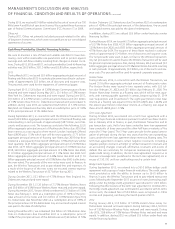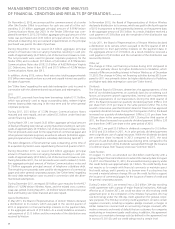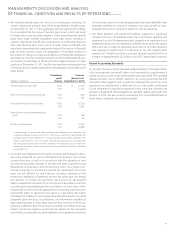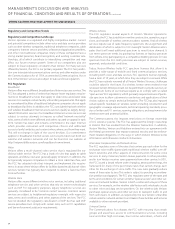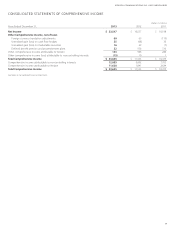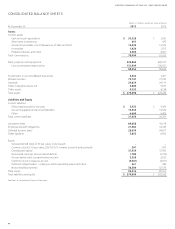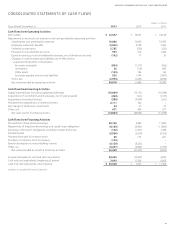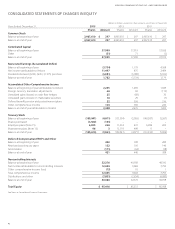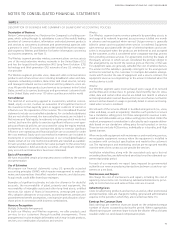Verizon Wireless 2013 Annual Report Download - page 37
Download and view the complete annual report
Please find page 37 of the 2013 Verizon Wireless annual report below. You can navigate through the pages in the report by either clicking on the pages listed below, or by using the keyword search tool below to find specific information within the annual report.
35
MANAGEMENT’S DISCUSSION AND ANALYSIS
OF FINANCIAL CONDITION AND RESULTS OF OPERATIONS continued
libraries, rural health-care organizations, and deaf and hard-of-hearing
individuals.TheFCCestablisheddierentsubsidyanddiscountprograms
toachievethesegoals.Topayfortheseprograms,theFCCrequirescon-
tributions from providers such as Verizon based on reported revenues for
certain services. Verizon also receives some payments from some of these
programs but is a net payer into them.
State Regulation and Local Regulation
Wireline Services
StatepublicutilitycommissionsregulateVerizon’stelephoneoperations
with respect to certain telecommunications intrastate matters. Verizon
operatesasan“incumbentlocalexchangecarrier”in14states.These
incumbent operations are subject to various levels of pricing exibility
and other state oversight and requirements. Verizon also has other wire-
line operations that are more lightly regulated. In addition, as a video
services operator in many states, Verizon has been required to obtain
a cable franchise from local government entities, or in some cases a
state-wide franchise, and to comply with certain one-time and ongoing
obligations as a result.
Wireless Services
The Communications Act generally preempts regulation by state and
local governments of the entry of, or the rates charged by, wireless car-
riers.TheActdoesnotprohibitstatesfromregulatingtheother“terms
andconditions”ofwirelessservice.Forexample,somestatesattemptto
regulate wireless customer billing matters and impose reporting require-
ments. Several states also have laws or regulations that address safety
issues (e.g., use of wireless handsets while driving) and taxation matters.
In addition, wireless tower and antenna facilities are often subject to state
and local zoning and land use regulation, and securing approvals for new
or modied facilities is often a lengthy and expensive process.
Environmental Matters
During 2003, under a government-approved plan, remediation com-
menced at the site of a former Sylvania facility in Hicksville, New York
thatprocessednuclearfuelrodsinthe1950sand1960s.Remediation
beyond original expectations proved to be necessary and a reassessment
of the anticipated remediation costs was conducted. A reassessment of
costs related to remediation eorts at several other former facilities was
also undertaken. In September 2005, the Army Corps of Engineers (ACE)
acceptedtheHicksvillesiteintotheFormerlyUtilizedSitesRemedial
Action Program. This may result in the ACE performing some or all of the
remediation eort for the Hicksville site with a corresponding decrease
in costs to Verizon. To the extent that the ACE assumes responsibility
for remedial work at the Hicksville site, an adjustment to a reserve pre-
viously established for the remediation may be made. Adjustments to
the reserve may also be made based upon actual conditions discovered
during the remediation at this or any other site requiring remediation.
CAUTIONARY STATEMENT CONCERNING
FORWARD-LOOKING STATEMENTS
In this report we have made forward-looking statements. These state-
ments are based on our estimates and assumptions and are subject to
risksanduncertainties.Forward-lookingstatementsincludetheinforma-
tion concerning our possible or assumed future results of operations.
Forward-lookingstatements alsoincludethoseprecededor followed
bythewords“anticipates,”“believes,”“estimates,”“hopes”orsimilarexpres-
sions.Forthosestatements,weclaimtheprotectionofthesafeharborfor
forward-looking statements contained in the Private Securities Litigation
ReformActof1995.
The following important factors, along with those discussed elsewhere
in this report and in other filings with the Securities and Exchange
Commission (SEC), could aect future results and could cause those
results to dier materially from those expressed in the forward-looking
statements:
• the ability to realize the expected benets of the Wireless Transaction
in the timeframe expected or at all;
• an adverse change in the ratings aorded our debt securities by
nationally accredited ratings organizations or adverse conditions in
thecreditmarketsaecting thecost,including interestrates, and/or
availability of further nancing;
• signicantly increased levels of indebtedness as a result of the Wireless
Transaction;
• changes in tax laws or treaties, or in their interpretation;
• adverse conditions in the U.S. and international economies;
• material adverse changes in labor matters, including labor negotia-
tions,andanyresultingnancialand/oroperationalimpact;
• material changes in technology or technology substitution;
• disruptionofourkeysuppliers’provisioningofproductsorservices;
• changes in the regulatory environment in which we operate, including
any increase in restrictions on our ability to operate our networks;
• breaches of network or information technology security, natural disas-
ters, terrorist attacks or acts of war or signicant litigation and any
resulting nancial impact not covered by insurance;
• the eects of competition in the markets in which we operate;
• changes in accounting assumptions that regulatory agencies, including
the SEC, may require or that result from changes in the accounting
rules or their application, which could result in an impact on earnings;
• signicant increases in benet plan costs or lower investment returns
on plan assets; and
• the inability to implement our business strategies.


